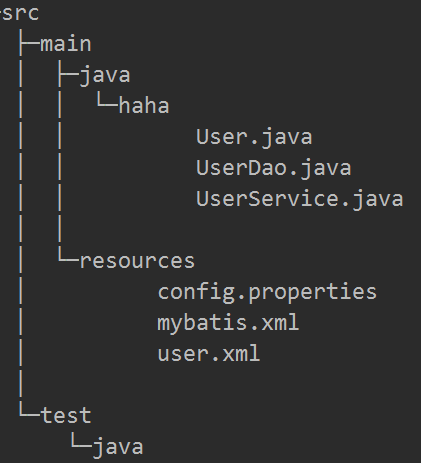Mybatis中的@SelectKey注解
一、创建Maven项目
在pom.xml中,添加mybatis依赖,mysql-jdbc依赖,把编译版本改为1.8
你问,为啥mybatis不会自动依赖mysql-jdbc,需要手动写明?答:因为mysql驱动是通过字符串动态加载的,这是一种“动态依赖”,Maven只能推导出“静态依赖”。“动态依赖”是一种更加灵活的依赖。
Maven默认的Java版本是1.6,无法使用lambda表达式(1.8)和钻石运算符(1.7)。
代码片段:pom.xml
<?xml version="1.0" encoding="UTF-8"?>
<project xmlns="http://maven.apache.org/POM/4.0.0"
xmlns:xsi="http://www.w3.org/2001/XMLSchema-instance"
xsi:schemaLocation="http://maven.apache.org/POM/4.0.0 http://maven.apache.org/xsd/maven-4.0.0.xsd">
<modelVersion>4.0.0</modelVersion>
<groupId>wyf</groupId>
<artifactId>xqweb</artifactId>
<version>1.0-SNAPSHOT</version>
<dependencies>
<!-- https://mvnrepository.com/artifact/org.mybatis/mybatis -->
<dependency>
<groupId>org.mybatis</groupId>
<artifactId>mybatis</artifactId>
<version>3.4.4</version>
</dependency>
<!-- https://mvnrepository.com/artifact/org.springframework/spring-jdbc -->
<!-- https://mvnrepository.com/artifact/mysql/mysql-connector-java -->
<dependency>
<groupId>mysql</groupId>
<artifactId>mysql-connector-java</artifactId>
<version>6.0.6</version>
</dependency>
</dependencies>
<build>
<plugins>
<plugin>
<groupId>org.apache.maven.plugins</groupId>
<artifactId>maven-compiler-plugin</artifactId>
<configuration>
<source>1.8</source>
<target>1.8</target>
<encoding>utf8</encoding>
</configuration>
</plugin>
</plugins>
</build>
</project>
创建好了pom.xml,就可以开始编码了。最终的目录结构如下,下面让我们来一步一步创建文件。

二、配置Mybatis
代码片段:mybatis.xml
<?xml version="1.0" encoding="UTF-8" ?>
<!DOCTYPE configuration
PUBLIC "-//mybatis.org//DTD Config 3.0//EN"
"http://mybatis.org/dtd/mybatis-3-config.dtd">
<configuration>
<properties resource="config.properties">
</properties>
<environments default="development">
<environment id="development">
<transactionManager type="JDBC"/>
<dataSource type="POOLED">
<property name="driver" value="${driver}"/>
<property name="url" value="${url}"/>
<property name="username" value="${username}"/>
<property name="password" value="${password}"/>
</dataSource>
</environment>
</environments>
<mappers>
<mapper class="haha.UserDao"/>
<mapper resource="user.xml"/>
</mappers>
</configuration>
代码片段:config.properties
username=root
password=haha
driver=com.mysql.jdbc.Driver
url=jdbc:mysql://localhost:3306/test?serverTimezone=Asia/Shanghai
把配置信息跟mybatis.xml分开的好处是:更清晰。mybatis属于代码区,config.properties改起来比较简单。
三、创建实体类User
User有三个属性:name,age和id,重写toString()方法便于调试。
package haha;
public class User {
String name;
Integer age;
Integer id;
public User(){}
public User(String name,int age){
this.name=name;
this.age=age;
}
public String getName() {
return name;
}
public void setName(String name) {
this.name = name;
}
public Integer getAge() {
return age;
}
public void setAge(Integer age) {
this.age = age;
}
public Integer getId() {
return id;
}
public void setId(Integer id) {
this.id = id;
}
@Override
public String toString() {
return String.format("(id:%d,name:%s,age:%d)", id, name, age);
}
}
相应的,在数据库中建立一个表user
CREATE TABLE `user` (
`id` int(11) NOT NULL AUTO_INCREMENT,
`name` varchar(10) DEFAULT NULL,
`age` int(11) DEFAULT NULL,
PRIMARY KEY (`id`)
) ENGINE=InnoDB AUTO_INCREMENT=119 DEFAULT CHARSET=utf8mb4
四、实现UserDao接口
UserDao接口有两个功能:插入、查询全部。
package haha;
import org.apache.ibatis.annotations.Insert;
import org.apache.ibatis.annotations.Param;
import org.apache.ibatis.annotations.Select;
import org.apache.ibatis.annotations.SelectKey;
import java.util.List;
public interface UserDao {
@Insert("insert into user(name,age) value(#{name},#{age})")
int insert_withoutPrimaryKey(@Param("name") String name, @Param("age") int age);
int insert_useGeneratedKey(@Param("user") User user);
int insert_selectKey(@Param("user") User user);
@Insert("insert into user(name,age) value(#{user.name},#{user.age})")
@SelectKey(statement = "select last_insert_id()", keyProperty = "user.id", before = false, resultType = int.class)
int insert_selectKeyAnotation(@Param("user") User user);
@Select("select*from user")
List<User> getAll();
}
Mybatis写SQL语句有两种方式:1、使用注解;2、使用xml
对于比较长的SQL语句放在xml中,对于比较短的SQL语句放在注解中
在上面定义的UserDao中,insert_userGeneratedKey()和insert_selectKey()两个函数没有给出对应的SQL语句,需要在xml文件中进行定义。
代码片段:user.xml
<?xml version="1.0" encoding="UTF-8" ?>
<!DOCTYPE mapper PUBLIC "-//mybatis.org//DTD Mapper 3.0//EN" "http://mybatis.org/dtd/mybatis-3-mapper.dtd">
<mapper namespace="haha.UserDao">
<insert id="insert_useGeneratedKey" parameterType="haha.User"
useGeneratedKeys="true" keyProperty="user.id">
insert into user set id=#{user.id},name=#{user.name},age=#{user.age}
</insert>
<insert id="insert_selectKey" parameterType="haha.User">
<selectKey keyProperty="user.id" keyColumn="id" order="AFTER" resultType="int">
SELECT last_insert_id()
</selectKey>
insert into user(name,age) VALUE (#{user.name},#{user.age})
</insert>
</mapper>
五、万事俱备,只欠东风
编写一个UserService类测试一下
package haha;
import org.apache.ibatis.io.Resources;
import org.apache.ibatis.session.SqlSession;
import org.apache.ibatis.session.SqlSessionFactory;
import org.apache.ibatis.session.SqlSessionFactoryBuilder;
import java.io.IOException;
import java.io.InputStream;
import java.util.List;
public class UserService {
public static void main(String[] args) throws IOException {
String resource = "mybatis.xml";
InputStream inputStream = Resources.getResourceAsStream(resource);
SqlSessionFactoryBuilder builder = new SqlSessionFactoryBuilder();
SqlSessionFactory factory = builder.build(inputStream);
SqlSession session = factory.openSession();
UserDao dao = session.getMapper(UserDao.class);
//使用默认主键
int affectedRows = dao.insert_withoutPrimaryKey("张三", 25);
System.out.println(affectedRows);
//使用useGeneratedKey,将主键注入到user.id中
User u = new User("张三", 17);
affectedRows = dao.insert_useGeneratedKey(u);
System.out.println(affectedRows + " " + u.getId());
//使用selectKey执行在插入之前或之后执行查询语句
affectedRows = dao.insert_selectKey(u);
System.out.println(affectedRows + " " + u.getId());
//使用selectKey注解的方式
affectedRows = dao.insert_selectKeyAnotation(u);
System.out.println(affectedRows + " " + u.getId());
session.commit();
List<User> a = dao.getAll();
a.forEach(System.out::println);
}
}
六、insert()函数返回值
如下代码,insert()函数的返回值为int类型,表示affectedRows,即受影响的行数,如果成功插入返回1,如果不成功插入,返回0。对于一切写操作(insert,update,delete),返回值都是affectedRows。
@Insert("insert into user(name,age) value(#{name},#{age})")
int insert(@Param("name") String name, @Param("age") int age);
七、关于@SelectKey
关于insert()有一种需求很常见:如何确定插入数据的主键。对于MySQL中的自增类型主键,无需提供主键可以直接插入。还是以insert()函数为例,这个SQL语句没有提供主键,主键是自增类型可以自动生成。
@Insert("insert into user(name,age) value(#{name},#{age})")
int insert(@Param("name") String name, @Param("age") int age);
下面介绍一个重要注解@SelctKey(statement="SQL语句",keyProperty="将SQL语句查询结果存放到keyProperty中去",before="true表示先查询再插入,false反之",resultType=int.class)
其中:
- statement是要运行的SQL语句,它的返回值通过resultType来指定
- before表示查询语句statement运行的时机
- keyProperty表示查询结果赋值给代码中的哪个对象,keyColumn表示将查询结果赋值给数据库表中哪一列
- keyProperty和keyColumn都不是必需的,有没有都可以
- before=true,插入之前进行查询,可以将查询结果赋给keyProperty和keyColumn,赋给keyColumn相当于更改数据库
- befaore=false,先插入,再查询,这时只能将结果赋给keyProperty
- 赋值给keyProperty用来“读”数据库,赋值给keyColumn用来写数据库
- selectKey的两大作用:1、生成主键;2、获取刚刚插入数据的主键。
- 使用selectKey,并且使用MySQL的last_insert_id()函数时,before必为false,也就是说必须先插入然后执行last_insert_id()才能获得刚刚插入数据的ID。
注意:
- 该注解相当于XML配置中的
<selectKey>的标签 - 与注解
@Insert,@InsertProvider,@Updateor@UpdateProvider搭配使用。在其他方法上将被忽略。 - 如果你指定了一个
@SelectKey注解,然后Mybatis将忽略任何生成的key属性通过设置@Options,或者配置属性。 - 属性: statement是要执行的sql语句的字符串数组, keyProperty是需要更新为新值的参数对象属性, before可以是true或者false分别代表sql语句应该在执行insert之前或者之后, resultType是keyProperty的Java类型, statementType是语句的类型,取Statement, PreparedStatement和CallableStatement对应的STATEMENT, PREPARED或者CALLABLE其中一个,默认是PREPARED。
1、举一个before=true的例子,新插入数据的id是当前表中行的个数
当before=true,可以通过SQL语句来填充insert语句中的某个参数,这个参数的名称可以通过keyProperty来指明。
@Insert("insert into user value(#{id},#{name},#{age})")
@SelectKey(statement="select count(1)from user", keyProperty="id", before=true, resultType=int.class)
int insert(@Param("name") String name, @Param("age") int age);
这个函数返回值是affectedRows,也就是插入成功返回1,插入失败返回0。
以上这段代码有一个大大的隐患,万万不能用在生产环境中。这个隐患就是:不能通过count()来确定id,多线程情况下有可能产生冲突。解决方案:可以使用UUID作为主键。
2、before=false的情况
注意keyProperty不能使基本类型,因为那样赋值之后就找不到了(相当于传值)
注解的方式
@Insert("insert into user(name,age) value(#{user.name},#{user.age})")
@SelectKey(statement = "select last_insert_id()", keyProperty = "user.id", before = false, resultType = int.class)
int insert_selectKeyAnotation(@Param("user") User user);
XML的方式
<insert id="insert_selectKey" parameterType="haha.User">
<selectKey keyProperty="user.id" keyColumn="id" order="AFTER" resultType="int">
SELECT last_insert_id()
</selectKey>
insert into user(name,age) VALUE (#{user.name},#{user.age})
</insert>
3、在Oracle中使用SelectKey生成主键,通常是“先查询得到主键,再进行插入”
DUAL表是Oracle中的神奇的表
使用序列作为主键
<insert id="insertSelective" parameterType="com.zehin.vpaas.base.domain.SfyHazardAnalysis">
<selectKey resultType="java.lang.Integer" order="BEFORE" keyProperty="hazardId">
SELECT SEQUENCE_1.NEXTVAL FROM DUAL
</selectKey>
insert into SFY_HAZARD_ANALYSIS
<trim prefix="(" suffix=")" suffixOverrides=",">
HAZARD_ID,
<if test="hazardTime != null"> HAZARD_TIME,</if>
<if test="hazardTitle != null"> HAZARD_TITLE, </if>
<if test="hazardMeasure != null"> HAZARD_MEASURE, </if>
<if test="buildId != null"> BUILD_ID, </if>
</trim>
<trim prefix=" values(" suffix=")" suffixOverrides=",">
#{hazardId,jdbcType=INTEGER},
<if test="hazardTime != null">#{hazardTime,jdbcType=VARCHAR},</if>
<if test="hazardTitle != null"> #{hazardTitle,jdbcType=VARCHAR}, </if>
<if test="hazardMeasure != null"> #{hazardMeasure,jdbcType=VARCHAR}, </if>
<if test="buildId != null"> #{buildId,jdbcType= INTEGER}, </if>
</trim>
lt;/insert>
使用GUID作为主键
<insert id="insertUser" parameterType="com.danny.mybatis.po.User">
<selectKey keyProperty="userId" order="BEFORE" resultType="java.lang.Integer">
select SYS_GUID() as userId from DUAL
</selectKey>
insert into T_USER(userId,userName,birthday,sex,address) values (#{userId},#{userName},#{birthday},#{sex},#{address}) </insert>
4、使用useGeneratedKeys
<insert id="insert" parameterType="Spares"
useGeneratedKeys="true" keyProperty="id">
insert into spares(spares_id,spares_name,
spares_type_id,spares_spec)
values(#{id},#{name},#{typeId},#{spec})
</insert>
<insert id="insertUser" useGeneratedKeys="true" keyColumn="id">
insert into user(name,age) VALUE (#{name},#{age})
</insert>
八、获取刚刚插入数据的主键
除了使用selectKey的方式获取刚刚插入数据的主键,还有以下方案:
1、如果是MySQL,可以用select last_insert_id()语句获取新插入数据的主键。
2、如果主键类型是UUID,可以直接在代码中生成主键进行插入,这样就不需要从数据库中读取主键了,主动权掌握在代码手中。
九、参考资料
Mybatis官方文档
CSDN偶尔记一下:mybatis如何获取oracle新插入数据记录的主键?
Mybatis中的@SelectKey注解的更多相关文章
- SpringBoot 集成MyBatis 中的@MapperScan注解
SpringBoot 集成MyBatis 中的@MapperScan注解 2018年08月17日 11:41:02 文火慢炖 阅读数:398更多 个人分类: 环境搭建 在SpringBoot中集成My ...
- mybatis中使用selectKey,返回结果一直是1
转:https://www.cnblogs.com/caizhen/p/9186608.html mybatis中使用selectKey,返回结果一直是1,结合这个问题,笔记一下selectKey标签 ...
- MyBatis中的@Mapper注解及配套注解使用详解(上)
前言: 从mybatis3.4.0开始加入了@Mapper注解,目的就是为了不再写mapper映射文件(那个xml写的是真的蛋疼...).很恶心的一个事实是源码中并没有对于这个注解的详细解释 现在我们 ...
- Mybatis中的@Param注解
前言 今天在使用Mybatis时遇到一个问题,主要出错原因在于Mybatis的@Param注解,如果我不在参数前面加上@Param注解,数据库操作就会报错,如下: @Param作用 @Param注解的 ...
- Mybatis中的@Param注解(自己没试过)
@Param是MyBatis所提供的(org.apache.ibatis.annotations.Param),作为Dao层的注解,作用是用于传递参数,从而可以与SQL中的的字段名相对应//https ...
- mybatis中:selectKey返回最近插入记录的id
<insert id="insert" parameterType="com.lls.model.Employee"> <!-- select ...
- MyBatis中的@Mapper注解 @Mappe与@MapperScan关系
从mybatis3.4.0开始加入了@Mapper注解,目的就是为了不再写mapper映射文件 现在项目中的配置 public interface DemoMapper{ int deleteByPr ...
- Springmvc和Mybatis中常用的注解
使用注解来构造IoC容器 用注解来向Spring容器注册Bean.需要在applicationContext.xml中注册<context:component-scan base-package ...
- Mybatis中的@param注解的用法
用注解来简化xml配置的时候,@Param注解的作用是给参数命名,参数命名后就能根据名字得到参数值,正确的将参数传入sql语句中 下午在写转账操作时,dao接口中的方法 @Update(update ...
随机推荐
- 借助 Resharper 和 StyleCop 让代码更整洁
一:工具安装 Resharper 和 StyleCop 必须安装. Resharper 的配置文件如下:Resharper.zip 请按如下步骤导入, 1: 2: 3: StyleCope 的配置 ...
- 卷积神经网络用于视觉识别Convolutional Neural Networks for Visual Recognition
Table of Contents: Architecture Overview ConvNet Layers Convolutional Layer Pooling Layer Normalizat ...
- Windows + IIS 环境部署Asp.Net Core App
环境:Windows Server 2012, IIS 8, Asp.Net Core 1.1. 不少人第一次在IIS中部署Asp.Net Core App的人都会遇到问题,会发现原来的部署方式无法运 ...
- cgroup子系统2_devices子系统
devices子系统用于控制cgroup中全部进程能够訪问哪些设备,三个控制文件:devices.allow,devices.deny,devices.list. devices.allow用于指定c ...
- spring中ApplicationContextAware接口使用理解
一.这个接口有什么用?当一个类实现了这个接口(ApplicationContextAware)之后,这个类就可以方便获得ApplicationContext中的所有bean.换句话说,就是这个类可以直 ...
- 今天微信小程序发现wx.request不好使了,调试报错: 小程序要求的 TLS 版本必须大于等于 1.2
今天微信小程序发现wx.request不好使了,调试报错: 小程序要求的 TLS 版本必须大于等于 1.2 查官方文档 解决方法 在 PowerShell中运行以下内容, 然后重启服务器 # Enab ...
- redis学习笔记——主从同步(复制)
在Redis中,用户可以通过执行SLAVEOF命令或者设置slaveof选项,让一个服务器去复制(replicate)另一个服务器,我们称呼被复制的服务器为主服务器(master),而对主服务器进行复 ...
- Missing styles. Is the correct theme chosen for this layout? Use the Theme combo box above the layou
android无法静态显示ui效果. Missing styles. Is the correct theme chosen for this layout? Use the Theme combo ...
- MySQL的各种SHOW
. SHOW语法 13.5.4.1. SHOW CHARACTER SET语法 13.5.4.2. SHOW COLLATION语法 13.5.4.3. SHOW COLUMNS语法 13.5.4.4 ...
- Eclipse——工作台
Workspace 磁盘区域.存放工作资料
